Hello guys, Formula Dynamics sells Larini exhaust headers for 3,000 USD. It's not cheap but the price may be justified. Before I seriously consider this option I would like to see what is the experience on this forum regarding the Larini exhaust headers (or any other options you guys may have used). First, I assume there will be some studs that will break off, will have to be drilled out, etc. Are these studs and nuts available for purchase? and what is the torque? I would expect the gaskets are available. Another question, are the exhaust headers on the US and Canadian cars different from the ROW (rest of the world) with those in North America being more restrictive? for those who took the plunge, have you noticed any difference in the UK/Europe replacing the factory exhaust headers with Larini? thank you,
You are using an out of date browser. It may not display this or other websites correctly.
You should upgrade or use an alternative browser.
You should upgrade or use an alternative browser.
Larini sport exhaust headers
- Thread starter gstroe
- Start date
Zep
Moderator
- Messages
- 9,336
This subject has been discussed quite a lot. Have a go with the search function. Here are a couple to start you off, you’ll wish you hadn’t asked! 
mjheathcote
Centenary Club
- Messages
- 9,046
If you have US headers with the primary cats in the headers, the benefits are that you are removing those cats, that are easily damaged and can then be 'sucked back' into the engine causing damage
If you have euro headers, not really any benefit, unless you have a breakdown with these being double skinned causing noise, when cold normally.
It appears any performance gains are slim across them all.
If you have euro headers, not really any benefit, unless you have a breakdown with these being double skinned causing noise, when cold normally.
It appears any performance gains are slim across them all.
From what I have gleaned from copious discussion on the forum boards;
Pretty much either type of header/cat set up is prone to having the disintegrating cats sucked back into the block. The later(US) type might actually appear more vulnerable as they are closer to the engine block but I dont believe experience really bears this out.. You can argue the earlier construction and placement makes these the ones more likely to fail...( glad you asked yet!??!)
With the US spec system...( cats in headers ) many favour the secondary cat delete. This shouldn't adversely affect emissions. Its easily enough done by replacing just a small section of pipe. Add an x-pipe for the full benefit. This means you can leave your O2 sensors where they are as well..KISS!
People have spent a small fortune in time & money trying to squeeze more bang from their 42L lumps. No one has reported any real gains AFAIK.
Larini look nice. You'll have to get your mate run you over so you can see them from underneath the car, even if its the last thing you do..?!?!
Pretty much either type of header/cat set up is prone to having the disintegrating cats sucked back into the block. The later(US) type might actually appear more vulnerable as they are closer to the engine block but I dont believe experience really bears this out.. You can argue the earlier construction and placement makes these the ones more likely to fail...( glad you asked yet!??!)
With the US spec system...( cats in headers ) many favour the secondary cat delete. This shouldn't adversely affect emissions. Its easily enough done by replacing just a small section of pipe. Add an x-pipe for the full benefit. This means you can leave your O2 sensors where they are as well..KISS!
People have spent a small fortune in time & money trying to squeeze more bang from their 42L lumps. No one has reported any real gains AFAIK.
Larini look nice. You'll have to get your mate run you over so you can see them from underneath the car, even if its the last thing you do..?!?!
Zep
Moderator
- Messages
- 9,336
From what I have gleaned from copious discussion on the forum boards;
Pretty much either type of header/cat set up is prone to having the disintegrating cats sucked back into the block. The later(US) type might actually appear more vulnerable as they are closer to the engine block but I dont believe experience really bears this out.. You can argue the earlier construction and placement makes these the ones more likely to fail...( glad you asked yet!??!)
With the US spec system...( cats in headers ) many favour the secondary cat delete. This shouldn't adversely affect emissions. Its easily enough done by replacing just a small section of pipe. Add an x-pipe for the full benefit. This means you can leave your O2 sensors where they are as well..KISS!
People have spent a small fortune in time & money trying to squeeze more bang from their 42L lumps. No one has reported any real gains AFAIK.
Larini look nice. You'll have to get your mate run you over so you can see them from underneath the car, even if its the last thing you do..?!?!
I agree, but I believe the sheer proximity of the cat to the head makes engine damage due to breakup more likely. The distance for debris to travel is a quarter of that for a Euro spec and there have been a few of them that have just blown the debris out of the back.
Zep
Moderator
- Messages
- 9,336
From what I have gleaned from copious discussion on the forum boards;
Pretty much either type of header/cat set up is prone to having the disintegrating cats sucked back into the block. The later(US) type might actually appear more vulnerable as they are closer to the engine block but I dont believe experience really bears this out.. You can argue the earlier construction and placement makes these the ones more likely to fail...( glad you asked yet!??!)
With the US spec system...( cats in headers ) many favour the secondary cat delete. This shouldn't adversely affect emissions. Its easily enough done by replacing just a small section of pipe. Add an x-pipe for the full benefit. This means you can leave your O2 sensors where they are as well..KISS!
People have spent a small fortune in time & money trying to squeeze more bang from their 42L lumps. No one has reported any real gains AFAIK.
Larini look nice. You'll have to get your mate run you over so you can see them from underneath the car, even if its the last thing you do..?!?!
I agree, but I believe the sheer proximity of the cat to the head makes engine damage due to breakup more likely. The distance for debris to travel is a quarter of that for a Euro spec and there have been a few of them that have just blown the debris out of the back.
Zep
Moderator
- Messages
- 9,336
Saying it twice doesnt make it more convincing Zep...!
People believce in God too. There's no evidence of this either...!
You haven’t seen the evidence so it’s your choice as to whether you believe it or not I guess
rockits
Member
- Messages
- 9,185
It seems rare for a CAT to break up suddenly unless it takes a big wack. Or gets splashed with cold water while very hot I've heard.
Normally a CAT will start to rattle a little and show plenty of signs of issues before break up completely. They are quite strong often I understand. A friend of mine was wacked a few out and he said they took a bit of work to break up and smash out.
Normally a CAT will start to rattle a little and show plenty of signs of issues before break up completely. They are quite strong often I understand. A friend of mine was wacked a few out and he said they took a bit of work to break up and smash out.
Hm, now you got me thinking with cats desintegrating and parts going into the engine = catastrophic damage. But OK, if the consensus is there are no gains to be had then I can think of better uses for 3,000 USD. FD speaks of them very highly so I thought I'd ask you all what you think about it => http://www.formuladynamics.com/products/4200_larini_headers/4200_larini_headers.php
JonW
Member
- Messages
- 3,262
I think it all depends on how much cash you are willing to spend... in my view, the perfect spec for a GS exhaust would be
- Larini headers (catless)
- Larini Sport Cats
- X Or H pipe (depends on aural preference)
- Modified Stock back boxes (as I prefer the rectangular exhaust pipes)
- Stock US style headers (with cats)
- Larini decat race pipes
- H pipe
- Stock back boxes
Hi JonW, I live in Canada and the car was sold in Canada so I assume it must have the US style headers. I have the X pipe and Larini boxes and IT IS LOUD! to the point that I am very gentle on the gas every time I see a police car nearby  It's winter and the roads are white with salt here, the car is in storage. But I will be pleased to record a clip and send it to you once warm weather shows up
It's winter and the roads are white with salt here, the car is in storage. But I will be pleased to record a clip and send it to you once warm weather shows up
George
George
lambertius
Banned
- Messages
- 341
Howdy,
I'd just like to throw my hat into the ring here.
The two headers aren't US and Euro, they're Euro 3 compliant and Euro 4 compliant. Euro 3 affected cars produced between 2001 and 2006, with Euro 4 coming into affect from 2006. https://en.wikipedia.org/wiki/European_emission_standards#Emission_standards_for_passenger_cars. Manufacturers are typically trying to meet the next standard several years before it becomes a compliance requirement, so will often experiment on engines already in the market to see if they will be viable for use in the next generation of cars or if they will need a new platform. This is the real reason why the usage of the headers seems somewhat random. Typically hot engines perform better due to https://en.wikipedia.org/wiki/Thermal_efficiency but hotter engines result in more https://en.wikipedia.org/wiki/Nitrogen_oxide which is bad. The way around this is to implement catalytic converters, but catalyst efficiency is temperature dependent so placement matters https://en.wikipedia.org/wiki/Catalytic_converter#Placement_of_catalytic_converters .
Our chassis was never designed to accommodate the F136 engine and the exhaust design demonstrates that. An important thing to remember with exhausts is that in terms of power they're extremely forgiving on bad design because they're under pressure and will always perform their function of letting gasses escape. This is important to keep in mind when thinking of exhaust options for this car because every option is literally a compromise due to packaging.
The Euro 3 header kept the cats hot by using a double skinned design; this is not a performance design even if it does have a performance implication. The reality is that air is a fantastic insulator so in cold start conditions the double skin keeps the hottest gasses getting to the cats to get them to operational temperature as soon as possible. https://www.researchgate.net/public...tem_design_based_on_heat_transfer_computation . The engineers used the dry sump ground clearance to package the cats under the engine to allow the headers to be longer.

The Euro 4 header needed to make a more stringent cold start requirement so the solution was to package the header closer to the exhaust ports. This trades off performance by shortening the headers with emissions performance. This design has an affect on the Larini headers as the heat shielding design is different.
The black line on this image is where the collectors on the Larini headers end - they're in effect a shorty style header. Larini would've done this so that they can sell the products as a proper bolt in product and compromised ideal performance for fitment. The changes for heat shielding on the Euro 4 headers are what dictates the overall shape, and therefore design, of the Larini headers.
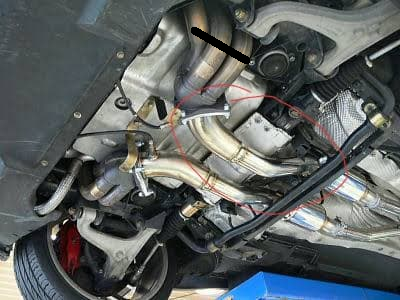
The point I'm trying to make is that there is no 'best' set of headers, they all serve a particular purpose. That said, as this is a forum for enthusiasts we all consider best to be related to a combination of sound and performance, so with that in mind - the Euro 3 headers are the best you can do with minimum fabrication.
In reality, the Euro 3 headers are still too short - our engine is low revving (yes, it is low revving, fight me IRL). This isn't one I can give you a formula or a justification for, this is just an 'in my experience comment'.
The below units are made by a shop called Best Mufflers in Sydney https://www.bestmufflers.com/bshop/Custom_Exhaust_Systems/Maserati_Custom_Exhaust_System.htm I called him when I started looking into an exhaust system for my car. He built them on a jig and can make another set. He wanted $7k AUD, which is 3600GBP today. Unfortunately that is way more than I can justify for my car but if I was choosing a new off the shelf set of headers I'd pick those over the Larini set. The downside is you will need to get someone to fabricate the mid-section.
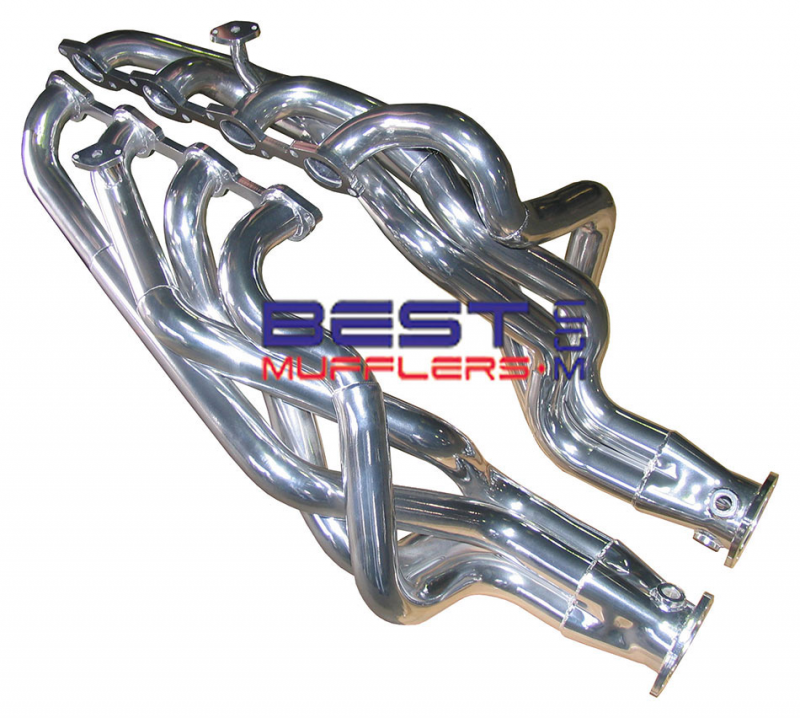
I'm getting a set of the Euro 3 headers modified to be longer as the cost is more reasonable and I get to customise the sound a bit further. The car was supposed to be at the exhaust shop today but that has been delayed for a few more days... The current plan is to cut off the collectors on the Euro 3 and extend the headers into an 8-1 collectors under the sump. We're 50:50 that it will fit, but we won't really know till the headers are on the car and the cutting starts. The CAD seems to show it will fit, but building it in practice is different.
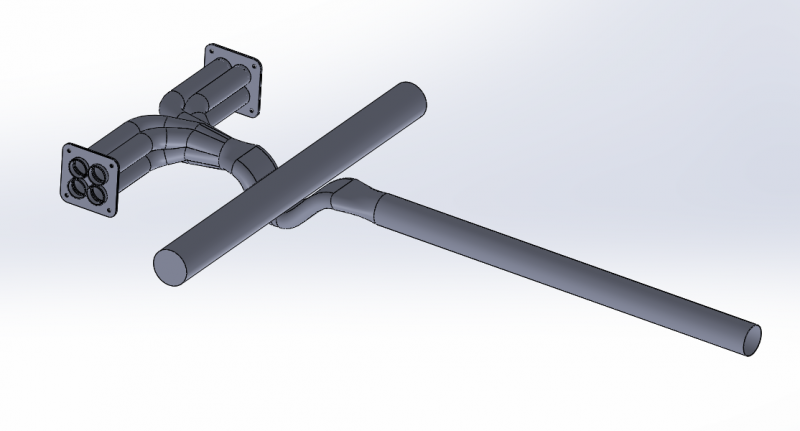

As for the performance part of the question; as I said before exhausts are very forgiving to bad design so changing exhaust components generally only yields 2-5% improvements on naturally aspirated cars. On this car, I believe if you had the money to do some experimenting you could probably see 7-10%, but most of that would just be in going from 4 high cell cats to proper high flow cats. People tend to be disappointed when they change exhaust parts and only get 5%, but the reality is that is a large improvement for exhaust components. Keep in mind that exhausts don't create power, or make power, what you're doing in practice is allowing gasses to escape more efficiently. That power was already there, so if you flip the way you think about it around it makes a lot more sense: Does my exhaust take up 10% of the engine's power to escape? When you think about it like that it almost seems ridiculous that an exhaust could consume that much energy. Also, keep in mind, 7-10% improvement is a peak improvement, you may see zero improvement in peak power, and depending on how you setup the exhaust you may even lose a bit of peak power. The below graph illustrates my point - peak improvement was 22% on this particular car, but peak power only improved by 16%.
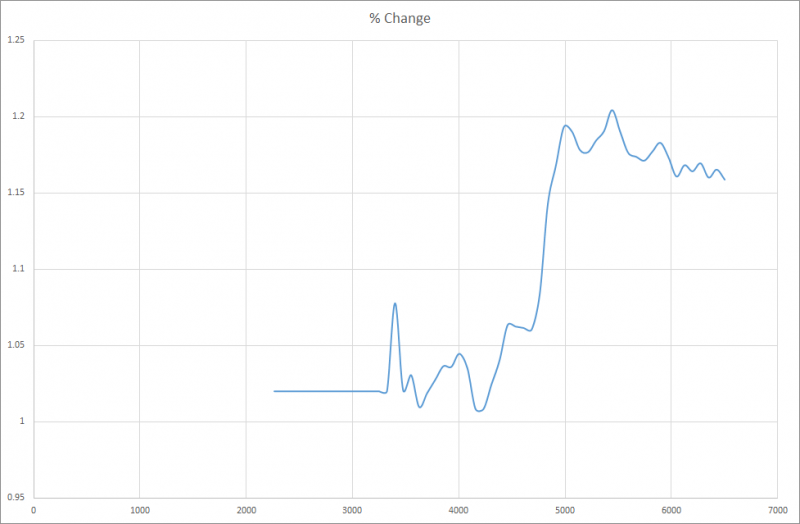
If sound is your main goal, well then no holds barred. Think about what kind of sound you want and go nuts. The engine is a cross-plane crank so you can magnify that characteristic or you can try and minimise it and smooth the sound. Regardless, removing the cats, going to headers of any length, it will sound better. The best set of headers compared to the worst set will at most affect your power output by 1-2%.
The biggest issue affecting after market car parts is grade-A marketing ****. Almost every dyno plot you see will be generic fake nonsense made in marketing departments. Wheel dynos are not SAE rated and so their numbers are almost always fake. This car sounds nice but it is not making 350 wheel horses
Maybe 290 on a good day.
This dyno plot is straight off the FD website for their ECM chip, this is absolutely fudge factor 9000.
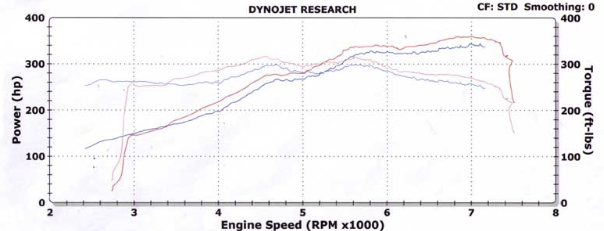
Fabspeed, same deal.
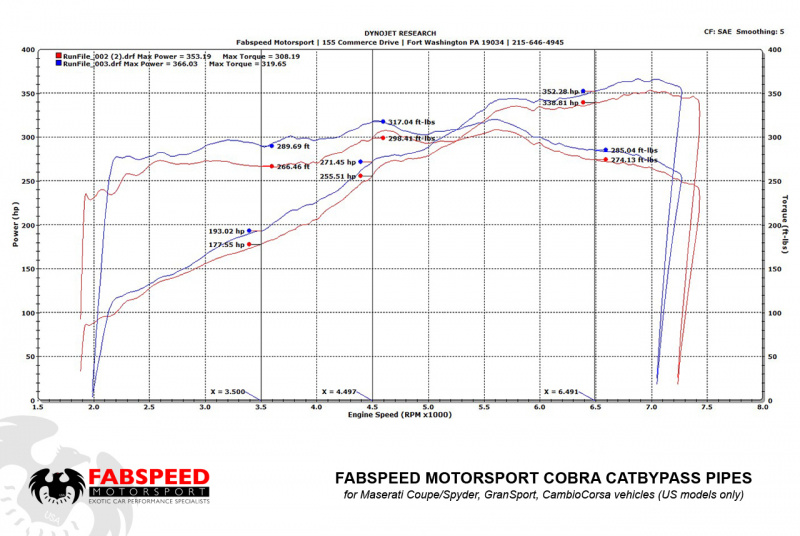
This dyno was measured in Australia from a shop I know. Power is in kW which is ~290 wheel horses.
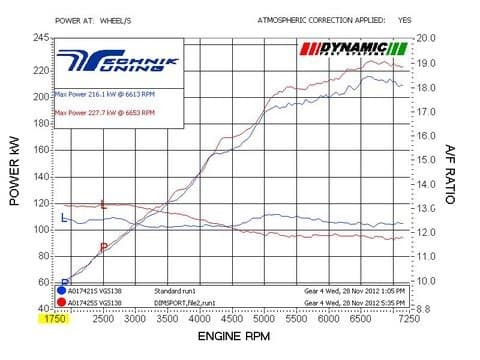
This my dyno plot over that dyno plot, keeping in mind these were recorded in different cities, years apart, with 50 000km difference between the engines and through a broken diff...
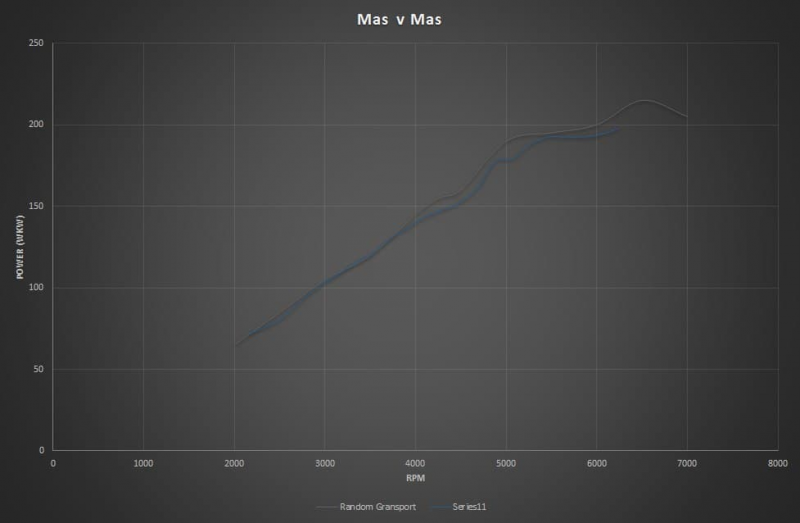
This is a really long winded way of saying don't buy into 'marketing' and 'speaking highly' of car parts. Try to understand a bit about why something was designed a particular way and then you can make an informed decision. Knowing your end goal will also make things a lot less confusing. But mostly, just have realistic expectations of what you can achieve.
Hope that helps.
I'd just like to throw my hat into the ring here.
The two headers aren't US and Euro, they're Euro 3 compliant and Euro 4 compliant. Euro 3 affected cars produced between 2001 and 2006, with Euro 4 coming into affect from 2006. https://en.wikipedia.org/wiki/European_emission_standards#Emission_standards_for_passenger_cars. Manufacturers are typically trying to meet the next standard several years before it becomes a compliance requirement, so will often experiment on engines already in the market to see if they will be viable for use in the next generation of cars or if they will need a new platform. This is the real reason why the usage of the headers seems somewhat random. Typically hot engines perform better due to https://en.wikipedia.org/wiki/Thermal_efficiency but hotter engines result in more https://en.wikipedia.org/wiki/Nitrogen_oxide which is bad. The way around this is to implement catalytic converters, but catalyst efficiency is temperature dependent so placement matters https://en.wikipedia.org/wiki/Catalytic_converter#Placement_of_catalytic_converters .
Our chassis was never designed to accommodate the F136 engine and the exhaust design demonstrates that. An important thing to remember with exhausts is that in terms of power they're extremely forgiving on bad design because they're under pressure and will always perform their function of letting gasses escape. This is important to keep in mind when thinking of exhaust options for this car because every option is literally a compromise due to packaging.
The Euro 3 header kept the cats hot by using a double skinned design; this is not a performance design even if it does have a performance implication. The reality is that air is a fantastic insulator so in cold start conditions the double skin keeps the hottest gasses getting to the cats to get them to operational temperature as soon as possible. https://www.researchgate.net/public...tem_design_based_on_heat_transfer_computation . The engineers used the dry sump ground clearance to package the cats under the engine to allow the headers to be longer.

The Euro 4 header needed to make a more stringent cold start requirement so the solution was to package the header closer to the exhaust ports. This trades off performance by shortening the headers with emissions performance. This design has an affect on the Larini headers as the heat shielding design is different.
The black line on this image is where the collectors on the Larini headers end - they're in effect a shorty style header. Larini would've done this so that they can sell the products as a proper bolt in product and compromised ideal performance for fitment. The changes for heat shielding on the Euro 4 headers are what dictates the overall shape, and therefore design, of the Larini headers.

The point I'm trying to make is that there is no 'best' set of headers, they all serve a particular purpose. That said, as this is a forum for enthusiasts we all consider best to be related to a combination of sound and performance, so with that in mind - the Euro 3 headers are the best you can do with minimum fabrication.
In reality, the Euro 3 headers are still too short - our engine is low revving (yes, it is low revving, fight me IRL). This isn't one I can give you a formula or a justification for, this is just an 'in my experience comment'.
The below units are made by a shop called Best Mufflers in Sydney https://www.bestmufflers.com/bshop/Custom_Exhaust_Systems/Maserati_Custom_Exhaust_System.htm I called him when I started looking into an exhaust system for my car. He built them on a jig and can make another set. He wanted $7k AUD, which is 3600GBP today. Unfortunately that is way more than I can justify for my car but if I was choosing a new off the shelf set of headers I'd pick those over the Larini set. The downside is you will need to get someone to fabricate the mid-section.

I'm getting a set of the Euro 3 headers modified to be longer as the cost is more reasonable and I get to customise the sound a bit further. The car was supposed to be at the exhaust shop today but that has been delayed for a few more days... The current plan is to cut off the collectors on the Euro 3 and extend the headers into an 8-1 collectors under the sump. We're 50:50 that it will fit, but we won't really know till the headers are on the car and the cutting starts. The CAD seems to show it will fit, but building it in practice is different.


As for the performance part of the question; as I said before exhausts are very forgiving to bad design so changing exhaust components generally only yields 2-5% improvements on naturally aspirated cars. On this car, I believe if you had the money to do some experimenting you could probably see 7-10%, but most of that would just be in going from 4 high cell cats to proper high flow cats. People tend to be disappointed when they change exhaust parts and only get 5%, but the reality is that is a large improvement for exhaust components. Keep in mind that exhausts don't create power, or make power, what you're doing in practice is allowing gasses to escape more efficiently. That power was already there, so if you flip the way you think about it around it makes a lot more sense: Does my exhaust take up 10% of the engine's power to escape? When you think about it like that it almost seems ridiculous that an exhaust could consume that much energy. Also, keep in mind, 7-10% improvement is a peak improvement, you may see zero improvement in peak power, and depending on how you setup the exhaust you may even lose a bit of peak power. The below graph illustrates my point - peak improvement was 22% on this particular car, but peak power only improved by 16%.

If sound is your main goal, well then no holds barred. Think about what kind of sound you want and go nuts. The engine is a cross-plane crank so you can magnify that characteristic or you can try and minimise it and smooth the sound. Regardless, removing the cats, going to headers of any length, it will sound better. The best set of headers compared to the worst set will at most affect your power output by 1-2%.
The biggest issue affecting after market car parts is grade-A marketing ****. Almost every dyno plot you see will be generic fake nonsense made in marketing departments. Wheel dynos are not SAE rated and so their numbers are almost always fake. This car sounds nice but it is not making 350 wheel horses
This dyno plot is straight off the FD website for their ECM chip, this is absolutely fudge factor 9000.

Fabspeed, same deal.

This dyno was measured in Australia from a shop I know. Power is in kW which is ~290 wheel horses.

This my dyno plot over that dyno plot, keeping in mind these were recorded in different cities, years apart, with 50 000km difference between the engines and through a broken diff...

This is a really long winded way of saying don't buy into 'marketing' and 'speaking highly' of car parts. Try to understand a bit about why something was designed a particular way and then you can make an informed decision. Knowing your end goal will also make things a lot less confusing. But mostly, just have realistic expectations of what you can achieve.
Hope that helps.



